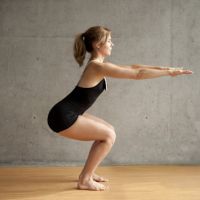The Awkward Pose – Instructions
The Awkward Pose is the third of the 26 Bikram Yoga poses that you will be performing as part of your session; it comes right after the Half-moon and Hands-to-Feet pose and before the Eagle Pose . The original name of this posture is Utkatasana which translates to “Frightening, wild pose.” It is also known by a few other names, including the Chair Pose, the Fierce Pose, the Lightning Bolt Pose, and a few others – in Bikram Yoga however only the name “Awkward” is officially used.
It might seem pretty simple if you’ve never tried it before and are only looking at pictures, but trust me – the Awkward posture is one of the most difficult poses you will perform, and it will require an immense amount of mental concentration, physical stability/balance, and muscle coordination. The pose gets more demanding with every next alteration, of which there are three, and which are performed in sequence.
Benefits & Purposes of The Awkward Pose
Similar to the Half-moon and Hands-to-feet pose, the Awkward posture will help warm up your entire body in preparation for the upcoming exercises. This is an exercises that focuses primarily on the development of your thighs and core (by core we mean the muscles of your body excluding the limbs), which will need to work in perfect harmony if you are to successfully execute the Utatasana. In particular, the following muscle groups are worked: the quadriceps, the calves, the abdominal muscles, the spinal erectors, and the front and rear deltoids.
As an additional “bonus,” the Awkward pose has been scientifically proven to help people with chronically cold feet, and to help reduce the side effects of both arthritis and rheumatism in the lower body. This exercise will also help get fresh blood moving across your cardiovascular system, providing your joints (especially the ankles and knees) with nutrients that will help strengthen and rebuild them.
Finally, many physicians recommend performing the Awkward posture (or a variation upon it) to patients who suffer from lower back problems, as well those who have experienced disc slippage.
How To Perform The Awkward Pose
The concept of this posture is really simple, however proper execution is demanding. The picture below illustrates the main position you’ll be going for:

- Stand tall with both your feet next to each other, then move the right foot far enough for a 6-inch gap to occur between your knees.
- Extend your arms in front of you, and make sure they are not relaxed – keep them flexed and straight at the elbows.
- Slowly lower your hips so that your thighs become parallel to the floor, and hold the position for a good minute (or however long you can / however long your instructor specifies).
- Go back up to straight position, only make sure to stand on your toes this time. Keep standing tall on your toes for a few seconds and then repeat the whole procedure above by bringing your hips down to where your thighs become parallel with the surface beneath you. This is the second iteration of the Awkward pose.
- Go back up to straight position again, and this time instead of putting the entire weight of your body on your toes, simply lift your heals off the ground just a little bit as if you were trying to add just one inch to your height, and repeat the awkward pose , only this time going down with your buttocks as low as you can until they almost touch the back of your heels. This is the third, final, and most demanding iteration of this posture.
Tips & Advice
- Do not maintain a gap between your fingers; keep them as close together as possible.
- Relax your shoulders throughout all three phases of the Awkward posture. This will keep them low and reduce stress on the joints.
- You’ll be tempted to breath faster than usual, though you should try to keep a normal respiration pace.
Awkward Pose (Utkatasana) How-To Video
The video below will provide you with a closer look at how the Awkward posture should be performed. Combined with the information you learned in this article, you will know all that there is to know about properly performing the Utkatasana – the rest is a matter of practice.